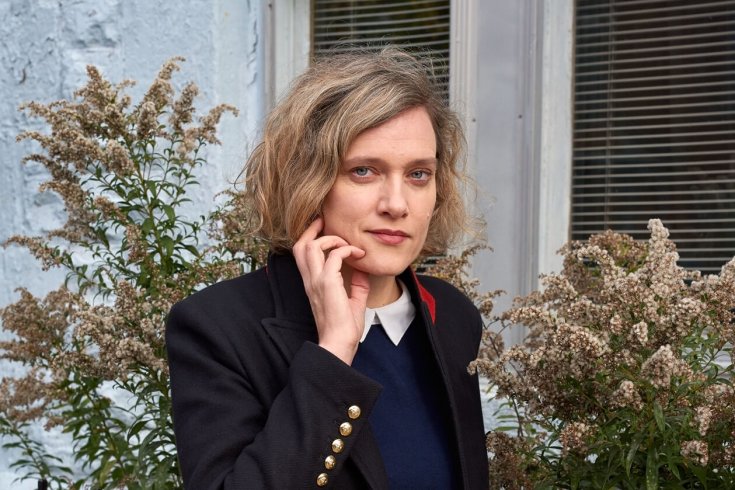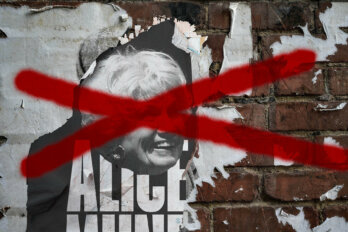In the postscript to her first novel, Lullabies for Little Criminals (2006), Heather O’Neill tells the story of how, as a child, she buried her copy of Sleeping Beauty in the yard. Fairy tales, she recalled, “made me sick to my stomach—they were so traumatizingly real.”
“Traumatizingly real” is probably not how most of us would describe a genre that features talking birds, magical shoes, and looms that spin gold. But it’s worth remembering that fairy tales also offer up an unrelenting parade of abandoned children, murderous parents, butchered wives, and cannibalistic grannies. To adapt a phrase from British novelist A. S. Byatt, fairy tales are a form of psychological terrorism. They use magic and fantasy to lure children into experiencing what she calls “the dreadful side of the nature of things.” Why does Sleeping Beauty fall into a long sleep after pricking her finger on a spindle? Because her father, having been warned this would happen, tries to destroy every spinning wheel in the land—thereby unintentionally ensuring that when his daughter does encounter one, she doesn’t know how to use it.
O’Neill has often been praised for writing fundamentally uplifting fiction about poverty, Montreal, and the lives of young women. In truth, she is a profoundly pessimistic writer. But she can write novels filled with drug use, coerced sex, and gangland killings and have publishers label them “magical” because she scatters striking, playful metaphors across their pages like confetti. A rundown apartment smells “as if a florist shop had caught on fire and all the flowers were burning.” Smoke from a cigar resembles “little girls in pyjamas who ran as fast as they could and crawled behind the couch and under the lampshade, playing hide-and-seek.”
After three books, O’Neill has elevated her gift for mixing whimsy with trauma into a scintillating style, one that has established her as a leading light in a younger generation of Canadian writers that includes Rawi Hage, Madeleine Thien, and Sheila Heti. But her style also risks becoming formulaic. If a young woman in an O’Neill story sees a wild-looking man wearing a leather jacket and a top hat in the park, we know she’ll fall in love with him, just as we know he’ll turn out to run a cockfighting ring out of his basement. As Leslie Scrivener noted in the Toronto Star, O’Neill’s metaphors can start to feel like candy. “At some point,” she writes, “you know you’ve had your fill.”
Her new novel, The Lonely Hearts Hotel, reads like a book-length fairy tale. Set in early twentieth-century Montreal, it features two children, Rose and Pierrot, who are abandoned at birth and raised in an orphanage, where they suffer many cruelties but develop preternatural gifts for song and dance. When they enter adolescence, they are separated by a spiteful nun. Pierrot becomes the piano-playing protege of a lonely aristocrat, while Rose is hired as a nanny by a powerful nightclub owner. Both go from rags to riches and back again in a world of opium dens, hard-living chorus girls, and depressed clowns. When they’re finally reunited, they try to make their dreams of fame and fortune come true by mounting a production that is one part circus, one part cabaret, and one part existentialism seminar. The Lonely Hearts Hotel, in other words, succeeds because in it we find O’Neill doing what she does well: spinning a mesmerizing narrative that isn’t particularly realistic and yet somehow doesn’t require a total suspension of disbelief.
But does the novel offer anything new? Most artists will have three basic ideas over the course of their career: the idea that gets them noticed, the idea that proves they aren’t a one-trick pony, and the idea that synthesizes a lifetime of work. Until now, O’Neill hasn’t moved far past her initial breakthrough. Does The Lonely Hearts Hotel mark the beginning of her second act?
The story of how O’Neill went from being a bookish urchin from the rougher corners of the Notre-Dame-de-Grâce (NDG) neighbourhood of Montreal to that city’s foremost chronicler of sweetness and grimness has become its own kind of fairy tale. Born in 1973, O’Neill spent her early years living a migratory life with her artistic but not particularly stable mother in the American South. After her mother left to become a punk rocker, O’Neill and her sisters were sent back to live with their father in anglo Montreal, where they were raised amongst junkies, charlatans, and crooks. Before she hit her teen years, O’Neill had already decided she wanted to become a writer. She attended McGill on a small scholarship because, as she once put it, “I knew from reading authors’ biographies that the majority went to university, so I went, too.” At the age of twenty, with one semester to go before graduation, she became pregnant. Her apprenticeship as a writer took place while she raised and provided for her daughter, Arizona.
These colourful early years provided rich inspiration for Lullabies for Little Criminals, which follows the clever and irrepressible Baby as she learns to navigate the harsh and beautiful world of Montreal’s St. Laurent Boulevard in the 1980s. O’Neill earned immediate accolades for her virtuosic metaphors, her magical portrayal of the decaying city, and her ability to write a novel that features parental neglect, drug addiction, and child prostitution, but isn’t crushingly depressing.
Though Baby’s world is filled with seedy apartments and heroin dealers, she has a way of seeing the miraculous in the tawdriest things. When she holds a conch shell to her ear, she hears not the ocean, but her mother laughing; insects in a car’s headlights are “scribbling out messages from God that we couldn’t get.” For all the squalor, Lullabies is a paean to the strange beauties of childhood, perhaps one of the most remarkable this country has produced. This fact did not go unnoticed: Lullabies won Canada Reads, the Orange Prize, and was nominated for the Governor General’s Award.
It took O’Neill eight years to produce her book-length follow-up, The Girl Who Was Saturday Night (2014). Set in the months leading up to the 1995 referendum, Girl follows Nouschka and Nicholas Tremblay, famous twin children of an aging and irresponsible separatist chansonnier, as they emerge from a wild and carefree adolescence and confront the realities of adult life. Told from the perspective of Nouschka, Girl is broader and more playful than Lullabies. Montreal served as a vivid backdrop for O’Neill’s first novel, but in the second, it becomes a subject in its own right. Nouschka punctuates the narrative with witty glosses on current events (“Our culture could disappear and all that would be left of it would be little French-Canadian bobble-head dolls dressed in lumber-jack shirts”). The tired grandeur of Montreal’s buildings, the tension between its two linguistic solitudes, the idiosyncrasies of Québécois culture—they are given as rich a treatment in Girl as they ever received in the works of Mordecai Richler, Hugh MacLennan, or Mavis Gallant.
If Lullabies and Girl were rooted in the louche, decaying Montreal of her childhood, her next book, a collection of short stories called Daydreams of Angels (2015), was filled with the kind of stories you imagine O’Neill amusing her companions with on long bus trips. There are forays into science fiction, magical realism, and metafiction. The finest story, “Swan Lake for Beginners,” is about a Soviet scientist who set up an experiment in Northern Quebec to create ideologically pure clones of the dancer Rudolf Nureyev (who defected to the West in 1961). The collection signalled that O’Neill was headed in a new direction. It just wasn’t clear where it would lead.
It led to The Lonely Hearts Hotel, O’Neill’s most gripping book to date. The novel stands out from her earlier work in two important ways. It’s set in a historical Montreal that O’Neill doesn’t know first-hand, which frees her from writing another coming-of-age story that tracks closely with her own life. And the novel is told in the third person, which allows the caustic notes in O’Neill’s voice to ring more clearly. The use of first-person narrators in her first two books limited what O’Neill herself could say. The moral observations produced by Baby and Nouschka, both optimistic and fundamentally earnest teenagers, were often oblique. The horror of Lullabies lies in the distance between the way Baby narrates an experience such as shooting up in a bathroom stall (“The woman in the picture began combing her hair. I whispered the word ‘shit’ and it came out of my mouth in calligraphic letters, like a cartoon”) and the way it would seem to anyone else (“Oh my God, there’s a twelve-year-old shooting up in the bathroom”).
Lonely Hearts, though, is ferociously direct. O’Neill has always been a writer with a keen eye for the special ways the world can be cruel to young women, but Lonely Hearts unleashes on the subject the full range of her rhetorical powers. Baby and Nouschka are aware, in a general way, that the deck is stacked against them, but they can’t articulate exactly why this is. Because they grew up in a world that had been shaped to some degree by the feminist movement, there were more options open to them. But when Rose visits a brothel, O’Neill describes her coming to the realization that all the women she sees are on heroin:
Being a woman was a trap. Something would bring you down before you turned twenty-three. The only time the world shows you any favour, or cuts you any slack, is during that very brief period of courtship where the world is trying to fuck you for the first time.
Later in the novel, when Rose is working at a porn photography studio, O’Neill describes her autodidactic co-star Mimi thus:
Mimi was the only person Rose had ever met who liked to read as much as she did . . . She was a genius. She should have been a lecturer at the university. She should have been touring around in a black suit and tie, talking about French history. She was here without her clothes on, though.
The sharpness of these passages is characteristic of the novel as a whole. Lonely Hearts is realistic about the price a woman has to pay to rise in the world. The only way Rose and Mimi can avoid becoming victims is by asserting themselves in traditionally masculine terms—which, in Rose’s case, involves handguns and running a large heroin-smuggling operation. O’Neill isn’t starry-eyed about what life was like for women in the Montreal of the 1930s, and despite the fact that Rose is able to claw her way up, the meaning of her story is fundamentally conservative. Once she’s won a place for herself at the table, she’s realistic about how much she can actually change. She is “a woman who had done what she needed to get free.” Now that she’s free, she’s got a business to run.
The “happily ever after” of Lonely Hearts, though, comes with a cost. Fairy tales are not fables, which teach you how to be a good person. Fairy tales teach you how to stay alive. Sometimes, the best way to stay alive is by pushing the witch into the oven. And sometimes one of the joys of staying alive is being given the opportunity to hurt the people who tried to kill you.
In the end, Rose succeeds in getting almost everything she wants. But she succeeds only because she is willing to become ruthless in a ruthless world. In the very last scene, she forgives the person who has been the cause of so much of her misery—right before sending her bodyguard to put a bullet in their brain. The life of the piano-playing, heroin-addicted Pierrot, who’s about as ruthless as a pigeon, follows a more tragic course.
Is this vision nihilistic? Maybe—but that word doesn’t seem right for a ravishing novel that, for all its brutality, retains a childlike appreciation for the fantastic. The hollow moon that hangs above the stage during the final act of Rose and Pierrot’s theatrical show is a symbol of wonder. But it’s also a hiding place for smuggled heroin. O’Neill’s accomplishment lies in convincing us it can be both of those things at once.
This appeared in the January/February 2017 issue under the headline “Ms. Lonelyhearts.”





